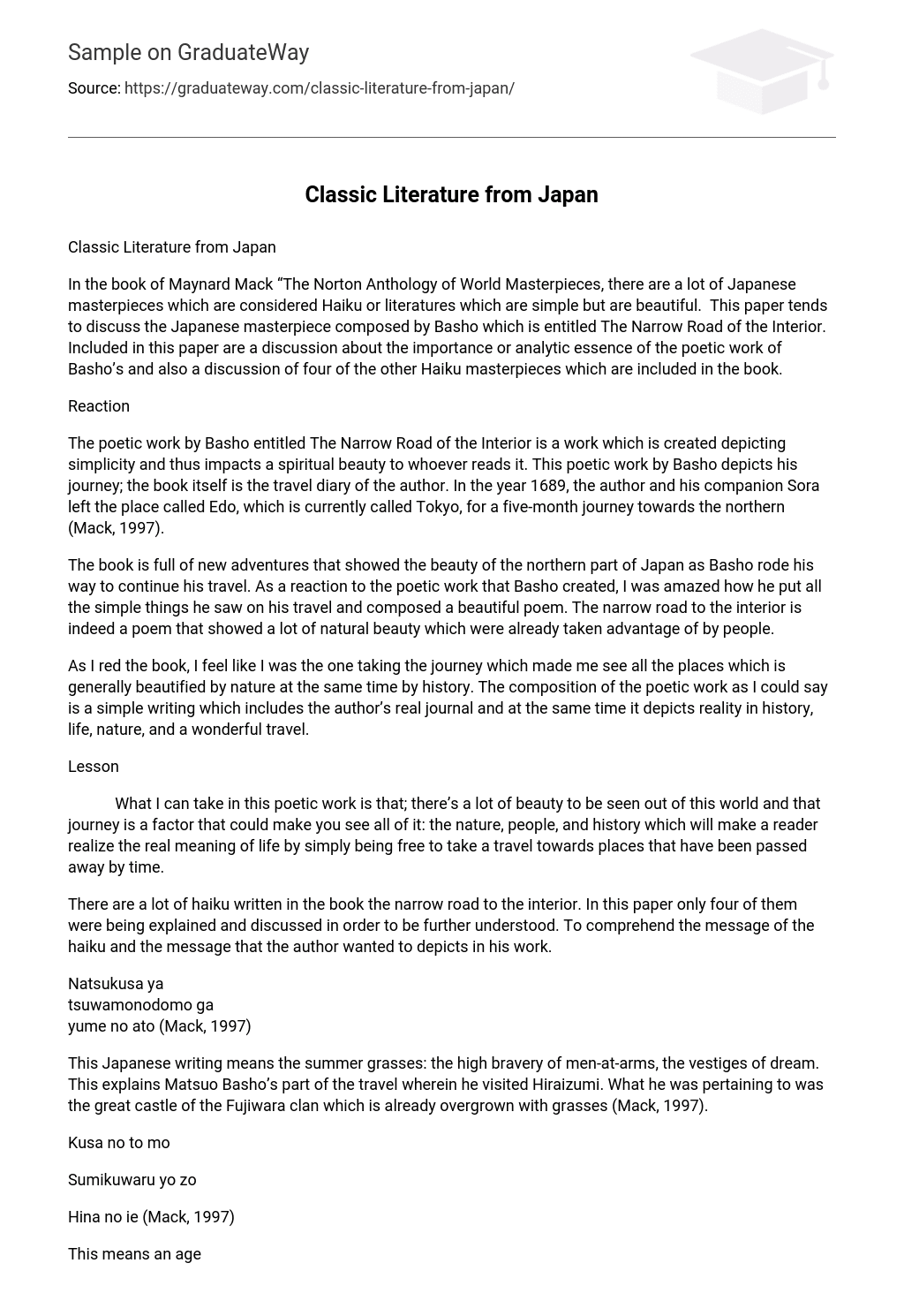In the book of Maynard Mack “The Norton Anthology of World Masterpieces, there are a lot of Japanese masterpieces which are considered Haiku or literatures which are simple but are beautiful. This paper tends to discuss the Japanese masterpiece composed by Basho which is entitled The Narrow Road of the Interior. Included in this paper are a discussion about the importance or analytic essence of the poetic work of Basho’s and also a discussion of four of the other Haiku masterpieces which are included in the book.
Reaction
The poetic work by Basho entitled The Narrow Road of the Interior is a work which is created depicting simplicity and thus impacts a spiritual beauty to whoever reads it. This poetic work by Basho depicts his journey; the book itself is the travel diary of the author. In the year 1689, the author and his companion Sora left the place called Edo, which is currently called Tokyo, for a five-month journey towards the northern (Mack, 1997).
The book is full of new adventures that showed the beauty of the northern part of Japan as Basho rode his way to continue his travel. As a reaction to the poetic work that Basho created, I was amazed how he put all the simple things he saw on his travel and composed a beautiful poem. The narrow road to the interior is indeed a poem that showed a lot of natural beauty which were already taken advantage of by people.
As I red the book, I feel like I was the one taking the journey which made me see all the places which is generally beautified by nature at the same time by history. The composition of the poetic work as I could say is a simple writing which includes the author’s real journal and at the same time it depicts reality in history, life, nature, and a wonderful travel.
Lesson
What I can take in this poetic work is that; there’s a lot of beauty to be seen out of this world and that journey is a factor that could make you see all of it: the nature, people, and history which will make a reader realize the real meaning of life by simply being free to take a travel towards places that have been passed away by time.
There are a lot of haiku written in the book the narrow road to the interior. In this paper only four of them were being explained and discussed in order to be further understood. To comprehend the message of the haiku and the message that the author wanted to depicts in his work.
Natsukusa ya
tsuwamonodomo ga
yume no ato (Mack, 1997)
This Japanese writing means the summer grasses: the high bravery of men-at-arms, the vestiges of dream. This explains Matsuo Basho’s part of the travel wherein he visited Hiraizumi. What he was pertaining to was the great castle of the Fujiwara clan which is already overgrown with grasses (Mack, 1997).
Kusa no to mo
Sumikuwaru yo zo
Hina no ie (Mack, 1997)
This means an age in which the person who occupies the grass hut made change- a doll of house. This English word meaning is depicting to Basho wherein he left his home depicted by the grass hut. And soon the man, who is Basho, will have his own family and the house or home will be changed because it will have new occupants; pertains to the new family and on the third day of the third said month, the house will be ornamented with little dolls honoring the Girl’s festival (Mack, 1997).
Akakize ni kusaki no tsuyu o
Harawasete kimi ga koyureba
Sekimori mo nashi (Mack, 1997)
This means making the autumn wind sweep its dew on the grass and trees, milord, cross, without barrier guard. This depicts the journey of Basho and Sora wherein they went to see the site of Shirakawa Barrier. Hence as they seek to see the view of the site, the two travelers did not see any signs of the shrine hence they still gave respect (Mack, 1997).
References
Mack, M. (1997). The Norton Anthology Of World Masterpieces: New York: W.W.Norton.





